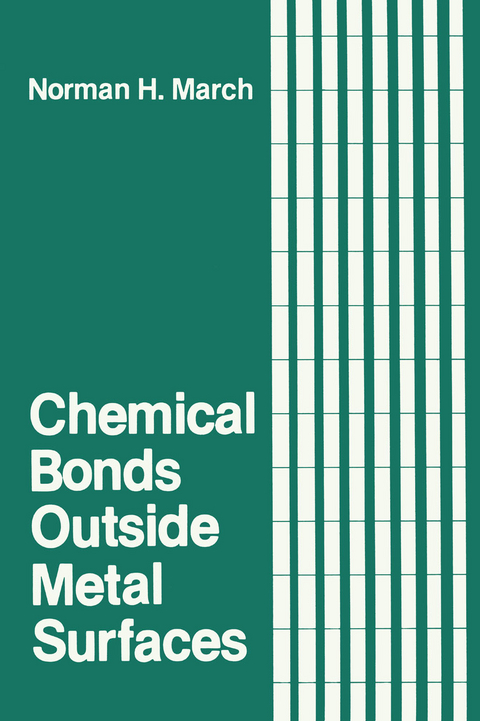
Chemical Bonds Outside Metal Surfaces
Springer-Verlag New York Inc.
978-1-4612-9252-4 (ISBN)
1. Background, Phenomenology, and Motivation.- 1.1. Chemisorption in Ionic and Covalent Limits.- 1.2. Kinetics of Adsorption and Desorption.- 1.3. Thermodynamics of Adsorption.- 1.4. Reaction Mechanisms Outside Surfaces.- 1.5. Case History of Catalytic Hydrogenation of Carbon Monoxide.- 2. Diatomic Molecules.- 2.1. Physisorbed Diatoms with Weil-Defined Cores.- 2.2.1. Physisorbed H2.- 2.3. Interaction Energy: Tight-Binding Model.- 2.4. Molecular Versus Dissociative Adsorption.- 2.5. Detailed Bonding Studies.- 2.6. Electronically Excited States of Chemisorbed Diatoms.- 2.7. Orientation of Molecular Adsorbates.- 2.8. Temperature Effects, and Comparison Between Theory and Experiment.- 3. Conformation and Electronic Structure of Polyatomic Molecules.- 3.1. Conformation of a Water Molecule Outside a Metal Surface.- 3.2. Conformation of NH3 and C2H4 Molecules.- 3.3. Molecular Versus Dissociative Adsorption of NH3 on Transition-Metal Surfaces.- 3.4. Electronic Structure and Conformation of Ethene on Transition- and Noble-Metal Surfaces.- 3.5. Interaction Between Adsorbates.- 3.6. Electronic Excited States of Chemisorbed Polyatomic Molecules.- 4. Dynamics of Adparticles and Neutron Inelastic Scattering.- 4.1. Principles of Neutron Scattering from Adsorbed Molecules.- 4.2. Comparison With Other Surface Techniques.- 4.3. Diffusion Measurements.- 4.4. Theory.- 4.5. Electronic and Vibration-Rotation Spectra of Adsorbed Molecules.- 4.6. Adsorbate Frequency Shifts.- 4.7. Theoretical Framework for Interpreting Neutron Inelastic Scattering From Covered Surfaces.- 4.8. Theory of Surface Diffusion.- 4.9. Vibration Excitation in Molecule-Surface Collisions Due to Temporary Negative Molecular-Ion Formation.- 4.10. Adparticle Dynamics: Kramers’ Equation in a Metallic Medium.- 5. MolecularDesorption.- 5.1. Kramers’ Theory Generalized to Desorption From Solid Surfaces.- 5.2. Transition-State Theory Applied to Desorption From Solid Surfaces: Ammonia on Ni(111).- 5.3. Microscopic Theories.- 5.4. Quantum-Statistical Theory of Physisorption.- 5.5. Coverage-Dependent Regime.- 5.6. Desorption Induced by Electronic Transitions.- 6. Catalysis.- 6.1. Some Definitions and Concepts.- 6.2. XPS Studies of Desorption and Dissociation Processes.- 6.3. Compensation Effect.- 6.4. Relevance of Woodward—Hoffmann Rules to Single-Crystal Catalysts.- 6.5. Electronic Structure Study of a “Poisoned” Catalyst Surface…..- 6.6. Chemical Oscillations.- Appendixes.- 1.1. Surface Characterization Techniques Used to Determine Structure and Composition of Solid Surfaces.- 2.1. Density Matrix and Linear-Response Function of the Infinite-Barrier Model of a Metal Surface.- 2.2. Influence of Fermi-Surface Topology on Asymptotic Displaced-Charge Round Adatoms.- 2.3. Correlation Effects for Hydrogen Chemisorbed on Transition Metals.- 2.4. Lifetimes of Excited States of Molecules Well Outside Metal Surfaces: a Model Calculation.- 3.2. Parametrization of the Tight-Binding Model of Ethene.- 3.3. Parametrization of the Anderson Hamiltonian Describing the ?-Energy Levels of the Free Ethene Molecule.- 4.1. Three-Dimensional Treatment of the Escape of a Brownian Particle From a Well.- 4.2. Dynamics of a Brownian Particle in a Fluid: Derivation of Stochastic Elements.- 4.3. Variational Principle for the Optimum Reaction Coordinate in Diffusion-Controlled Reactions.- 4.4. Anisotropic Screening of an Adatom Near a Metal Surface.- 5.1. Spin Fluctuations and Desorption of Hydrogen From Paramagnetic Metals.- 5.2. Anomalies in Adsorption Equilibrium Near Critical Points of a Substrate.- 6.1.Symmetry Rules Based on the Surface Electronic Structure of Various Platinum Surfaces.- 6.3. Analysis of Rate Equations Describing Chemical Oscillations.- 6.4. Proposed Reaction Sequence for Fischer-Tropsch Synthesis.- 6.5. Dissociative Chemisorption — A Primitive Surface Chemical Process.- 6.6. Nonlinear Rate Equations and the Compensation Effect.- Notes Added in Proof.- References.
| Reihe/Serie | Physics of Solids and Liquids |
|---|---|
| Zusatzinfo | 294 p. |
| Verlagsort | New York, NY |
| Sprache | englisch |
| Maße | 152 x 229 mm |
| Themenwelt | Sachbuch/Ratgeber ► Natur / Technik ► Garten |
| Naturwissenschaften ► Chemie ► Analytische Chemie | |
| Naturwissenschaften ► Chemie ► Physikalische Chemie | |
| Naturwissenschaften ► Geowissenschaften ► Mineralogie / Paläontologie | |
| Naturwissenschaften ► Physik / Astronomie ► Atom- / Kern- / Molekularphysik | |
| Naturwissenschaften ► Physik / Astronomie ► Festkörperphysik | |
| Naturwissenschaften ► Physik / Astronomie ► Thermodynamik | |
| ISBN-10 | 1-4612-9252-2 / 1461292522 |
| ISBN-13 | 978-1-4612-9252-4 / 9781461292524 |
| Zustand | Neuware |
| Haben Sie eine Frage zum Produkt? |
aus dem Bereich


